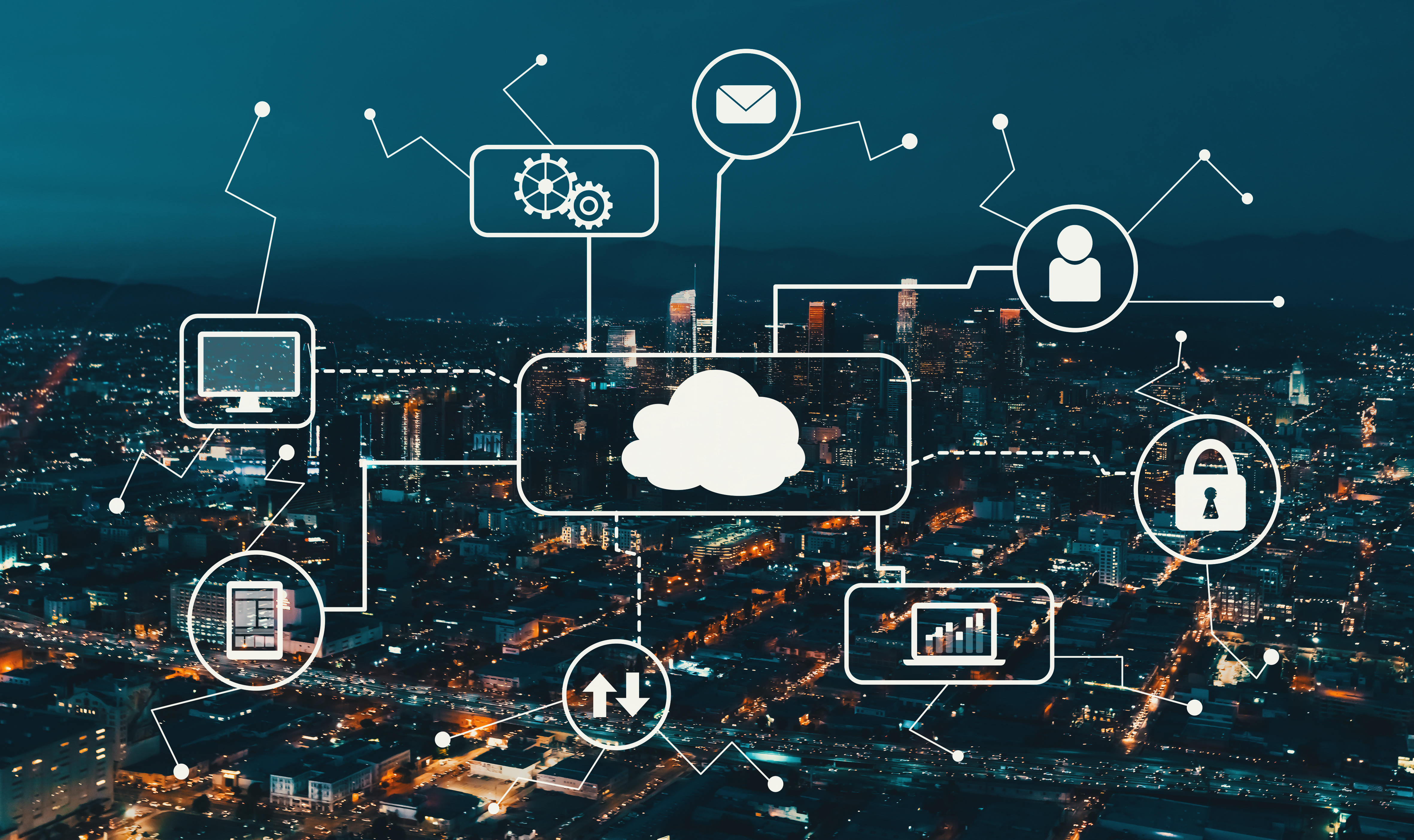The rise of cloud computing: Trends and predictions
Over the past decade, cloud adoption has accelerated at a remarkable pace. According to Zippia, 94% of organizations now use some form of cloud computing in their operations. Forbes Business Insights expects the cloud computing market to grow from $677 billion in 2023 to $2.4 billion in 2030.
This shift towards the cloud signals a new paradigm in cybersecurity. The cloud is new territory for many businesses, and cloud misconfigurations still account for many of the cloud security breaches.
Learn Cloud Security
![]()
As cloud computing continues to grow, organizations must keep track of emerging trends and adapt their cybersecurity strategies as the landscape changes to ensure system and data security. This article is here to provide you with a starting point.
The evolution of cloud computing

What is cloud computing? Although it's not the cloud computing definition we use today, the concept of the cloud originated in the 1950s with large-scale mainframes. Amazon Web Services (AWS) first provided an infrastructure-as-a-service (IaaS) model in 2006 that eliminated the need for organizations to operate their own physical servers. By providing instant scalability and computing power, IaaS enabled businesses to spin up resources as needed.
Over the following decade, the types of cloud computing grew. Platform as a service (PaaS) and software as a service (SaaS) solutions gained traction by abstracting away infrastructure complexities. PaaS allowed developers to deploy applications without managing underline resources. SaaS provided on-demand access to software applications over the internet. By 2016, cloud vendor revenues reached $148 billion, and the market was growing 25% annually.
Key cloud computing trends
Cloud computing also has not stopped evolving. There are several current trends that are shaping its landscape this year and into the future:
Hybrid cloud solutions and multi-cloud strategies
Hybrid and multi-cloud solutions, which combine public and private cloud environments, have gained significant traction in recent years. Using multiple cloud providers allows businesses to optimize resource allocation and keep control over sensitive data. According to the Flexera 2023 State of the Cloud Report, 87% of respondents use a multi-cloud strategy, and 72% use a hybrid cloud approach.
Quantum computing and its implications for the cloud
Quantum computing is just at the beginning but shows potential for handling complex calculations a lot faster in many industries, including finance, healthcare and scientific research. A report from Market Growth Reports states that while quantum computing was valued at $494 million in 2021, it is expected to reach almost $2 billion by 2027. The integration of quantum computing and cloud technology is a growing trend.
The rise of serverless computing
This on-demand model allows organizations to pay only for resources they use and eliminates the need to provision and manage servers. Because of the improved scalability and cost savings serverless provides, its use is growing at an astounding rate. According to Datadog, over 70% of their AWS customers, 60% of their Google Cloud customers and 49% of their Azure customers use serverless computing.
AI and machine learning integration in cloud platforms
Enterprise Strategy Group found that 39% of tech leaders consider artificial intelligence and machine learning as a top workload, and they will often search for other cloud providers to provide the infrastructure for their AI and machine learning workloads when their primary provider doesn't provide what they need.
The growth of containerization and Kubernetes
Containerization, powered by technologies like Docker and Kubernetes, provides lightweight and portable environments for cloud applications and simplifies development and deployment across a variety of cloud environments. According to the 2022 CNCF Annual Survey, 44% of organizations use containers for most or all production applications, and another 44% are piloting containerization or use them sometimes.
Cloud security: A new paradigm
The proliferation of cloud computing requires a fundamental shift in the way we do cybersecurity. Despite the advantages, migrating critical systems and sensitive data to public cloud environments also introduces new attack vectors and risk factors.
Cloud security is often misunderstood. Some of the common myths around it include:
-
Cloud security is the sole responsibility of the cloud provider: This responsibility is shared. The cloud provider is responsible for securing the cloud infrastructure, and the organization is responsible for securing data and applications.
-
Cloud security is less secure than on-premise security: While it can offer many advantages over on-premise security, it is more complex and requires knowing cloud computing fundamentals and principles.
-
Cloud security is a one-time process: Cloud security is not static but fluid and should respond to changing threats, risks and opportunities in the cloud environment.
The distributed and fluid nature of cloud deployments makes security fundamentally different from traditional on-prem models, but cloud computing vs cybersecurity is not a fair comparison. Cloud security is a specialization of cybersecurity. The principles remain the same, but the strategies differ. Ignoring the new paradigms of cloud security creates substantial risk in the modern digitized landscape.
Cybersecurity implications in cloud computing
As businesses increasingly embraced cloud computing, the need for robust cybersecurity measures has never been more critical. But the cloud's dynamic and interconnected nature presents unique cybersecurity challenges that organizations must address, including:
The shared responsibility model: Cloud provider vs. organization
In the shared responsibility model, the cloud provider secures the underlying infrastructure, including servers, storage and networking. But the organization is still responsible for securing its data, applications and network configurations. This model can lead to confusion and potential security gaps if not carefully managed.
Advanced threats targeting cloud providers
While providers offer robust physical environmental security, large cloud platforms are attractive targets for cyberattacks. In recent years, there have been several high-profile attacks on cloud providers, including data breaches, ransomware attacks and supply chain attacks.
The significance of governance and compliance in cloud environments
Depending on the type of data an enterprise stores, it could be subject to a wide range of regulations and compliance requirements, like HIPAA or GDPR. Organizations must implement appropriate governance and compliance frameworks to ensure their cloud environments meet these requirements.
The impact of GDPR on cloud security
The General Data Protection Regulation (GDPR) sets stringent rules for personal data protection. Organizations using cloud services must ensure their cloud providers comply with these requirements and offer appropriate data protection mechanisms.
The challenges posed by the Internet of Things (IoT) on cloud security
The Internet of Things (IoT) is rapidly expanding the number of connected devices, many of which are deployed in cloud environments. These devices require robust security measures and monitoring, so they don't become an entry point into the rest of your cloud environment.
Best practices for ensuring cloud security
Securing your cloud environment is crucial for protecting your data and applications from unauthorized access, data breaches and cyberattacks. Here are some best practices for ensuring cloud security:
-
Leverage cloud vendor security capabilities: Organizations should take advantage of the built-in security capabilities their cloud providers offer, such as identity and access management (IAM) tools, encryption services and security analytics.
-
Implement strong access controls: Organizations should not only use identity and access management tools (IAM), but also regularly review and update them to ensure only authorized users have access to sensitive data and resources.
-
Monitor and audit cloud activity: Using real-time threat detection tools, like intrusion detection systems and security information and event management (SIEM) tools, will help identify possible threats as they happen so they can be handled.
-
Educate and train employees: All employees can benefit from some form of cloud cybersecurity training. For those on the IT and cybersecurity teams, the CompTIA Cloud+ Learning Path will help transform them into cloud security engineers.
The future of cloud computing and cybersecurity
Cloud computing and cloud security work hand in hand. As one evolves, so must the other. Here are some things we may see in the future of cloud computing:
-
Growth of edge computing: This distributed computing model brings computing resources closer to the source of data, minimizes latency and enables real-time processing by IoT devices.
-
Cloud-delivered secure access service edge (SASE): SASE is one of the use cases for cloud computing that delivers wide area network (WAN) and security controls directly to the source of the connection.
-
Increased regulation: As cloud services become even more prevalent, we can expect more regulations around data privacy and security.
Even as these new innovations are being developed, threat actors will continue to refine their attacks. Investing in cybersecurity training, implementing advanced security measures required by new technologies and keeping up with the latest trends, will better equip businesses to keep their cloud environment secure in the future.
Learn Cloud Security
![]()
What’s next for cloud computing?
Cloud computing and cybersecurity are inextricably linked. As cloud computing transforms the way businesses operate and store their data, they must adopt new cybersecurity strategies that fit their new cloud-based model.
But keeping up with the rapid advancements on both the cloud technology and security fronts is not trivial. As both the cloud and cyber threats continue to evolve, organizations must prioritize ongoing cloud training to mitigate risk, ensure the security of their cloud infrastructure and safeguard their valuable data.




